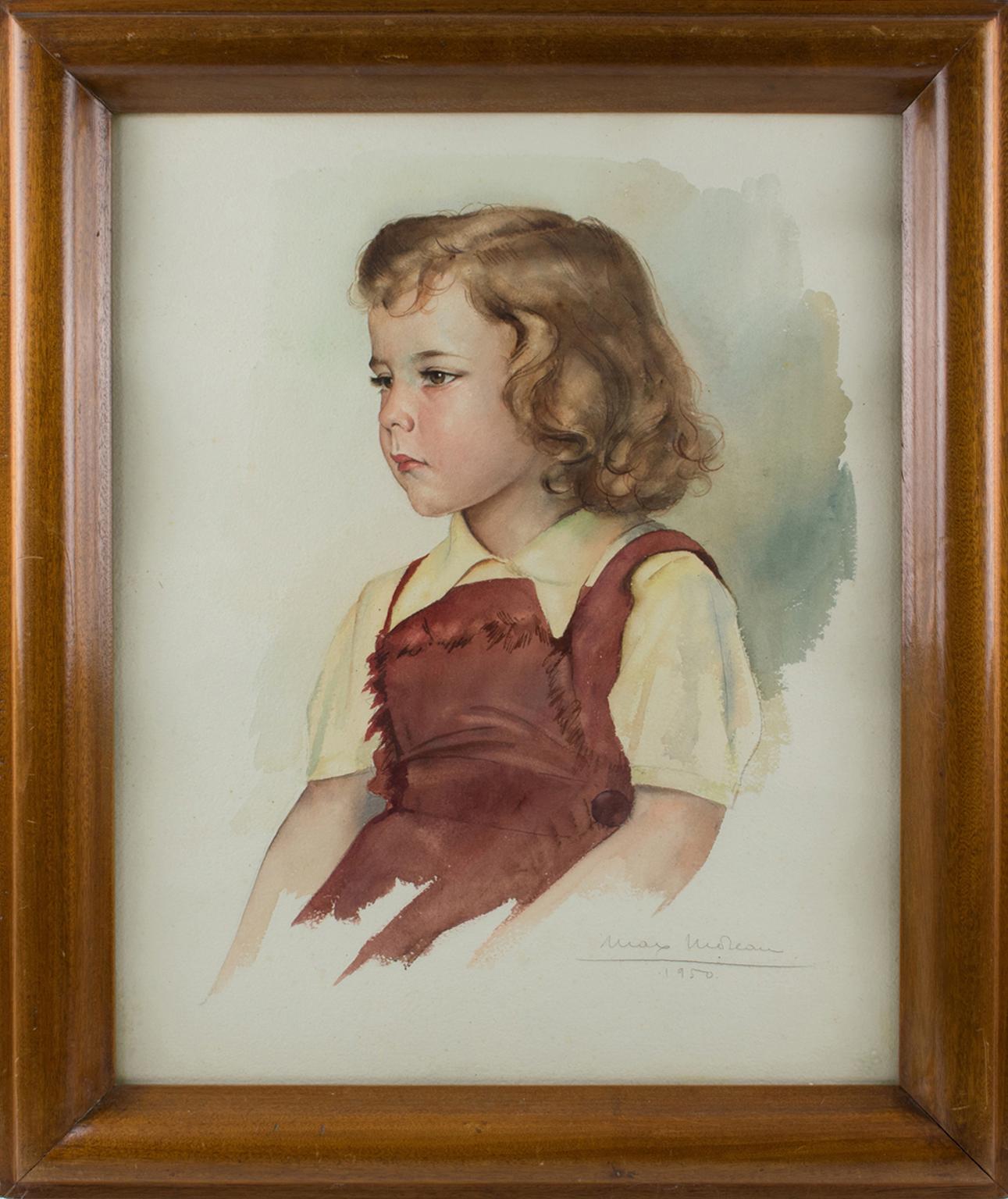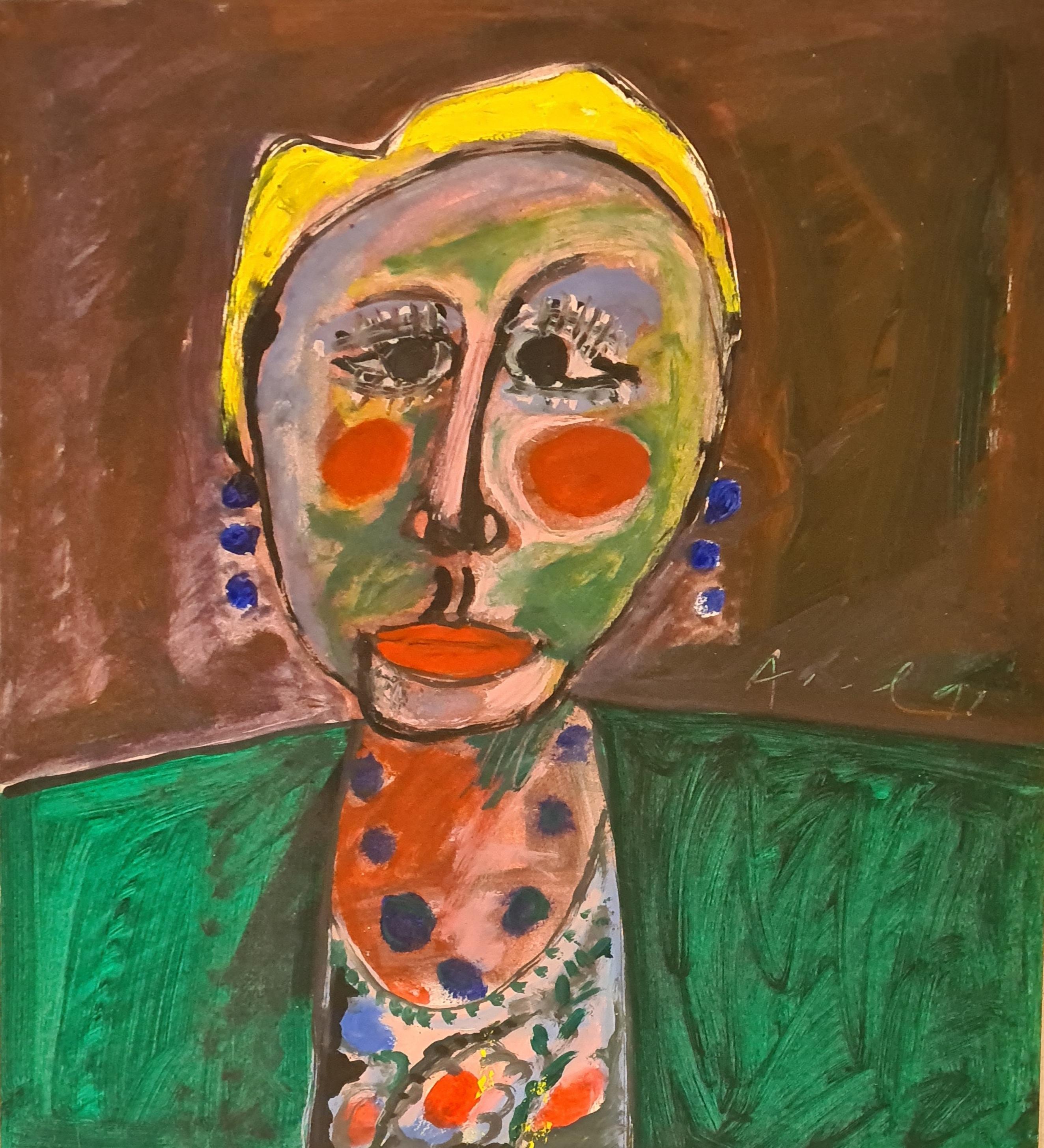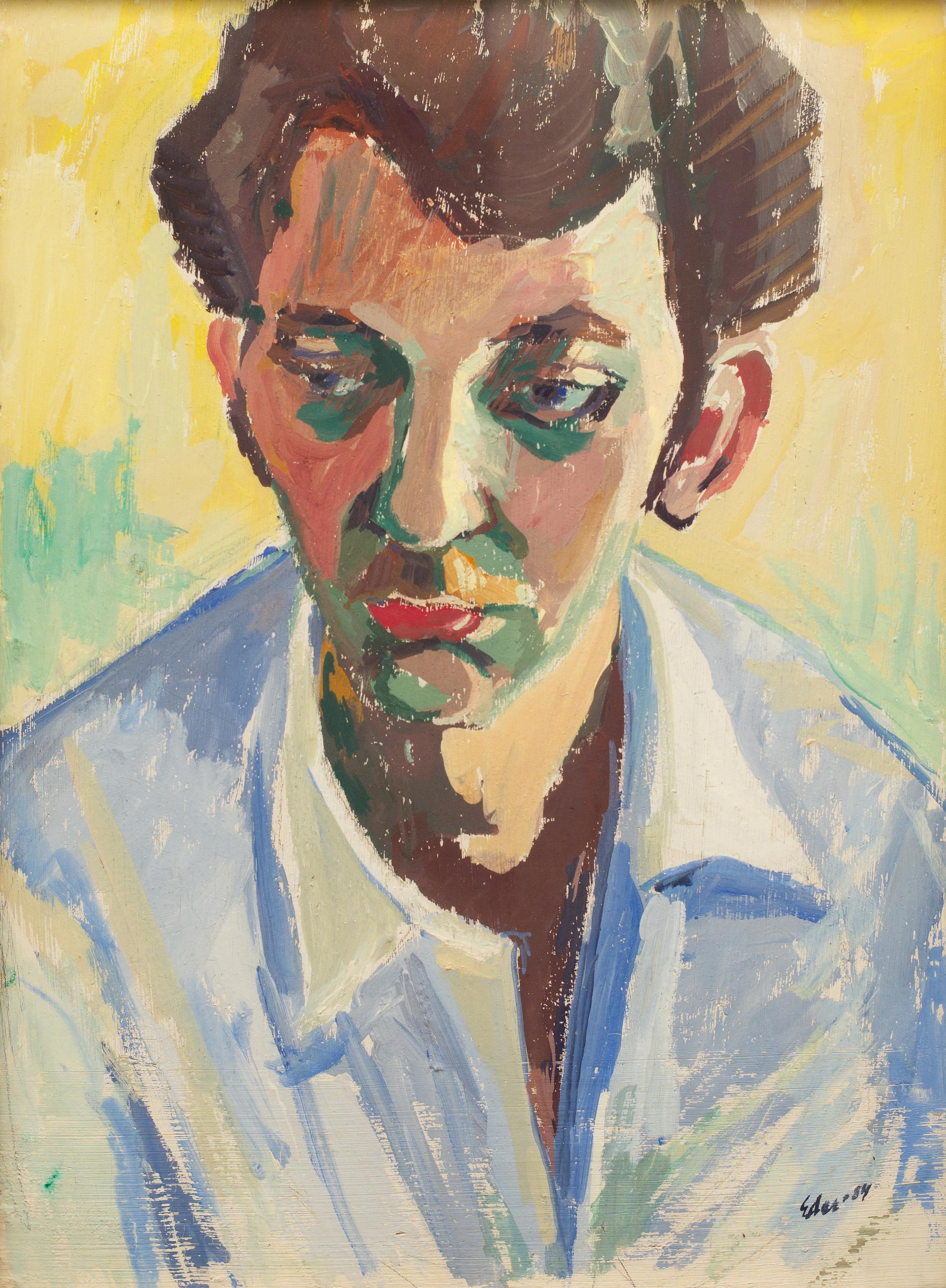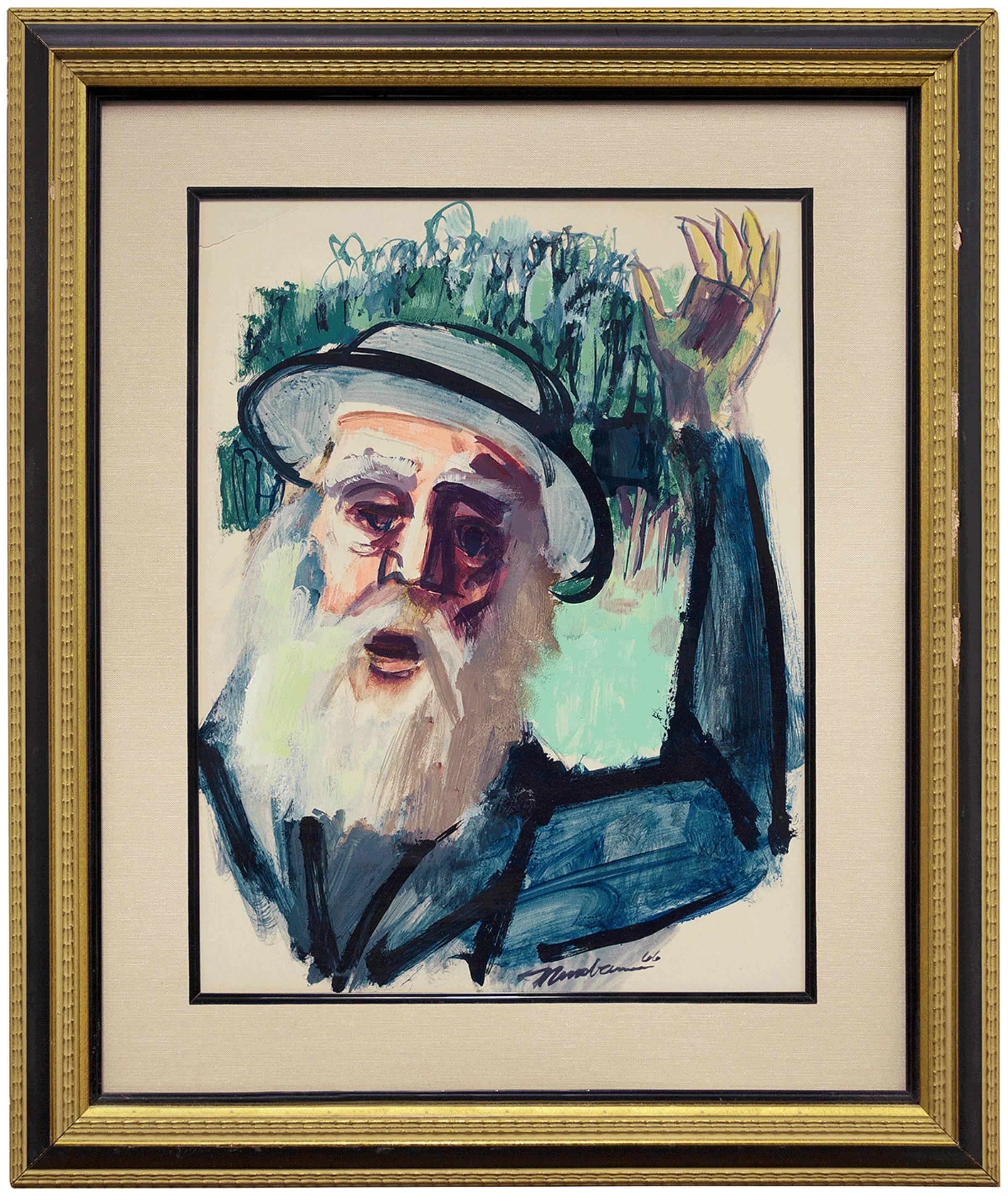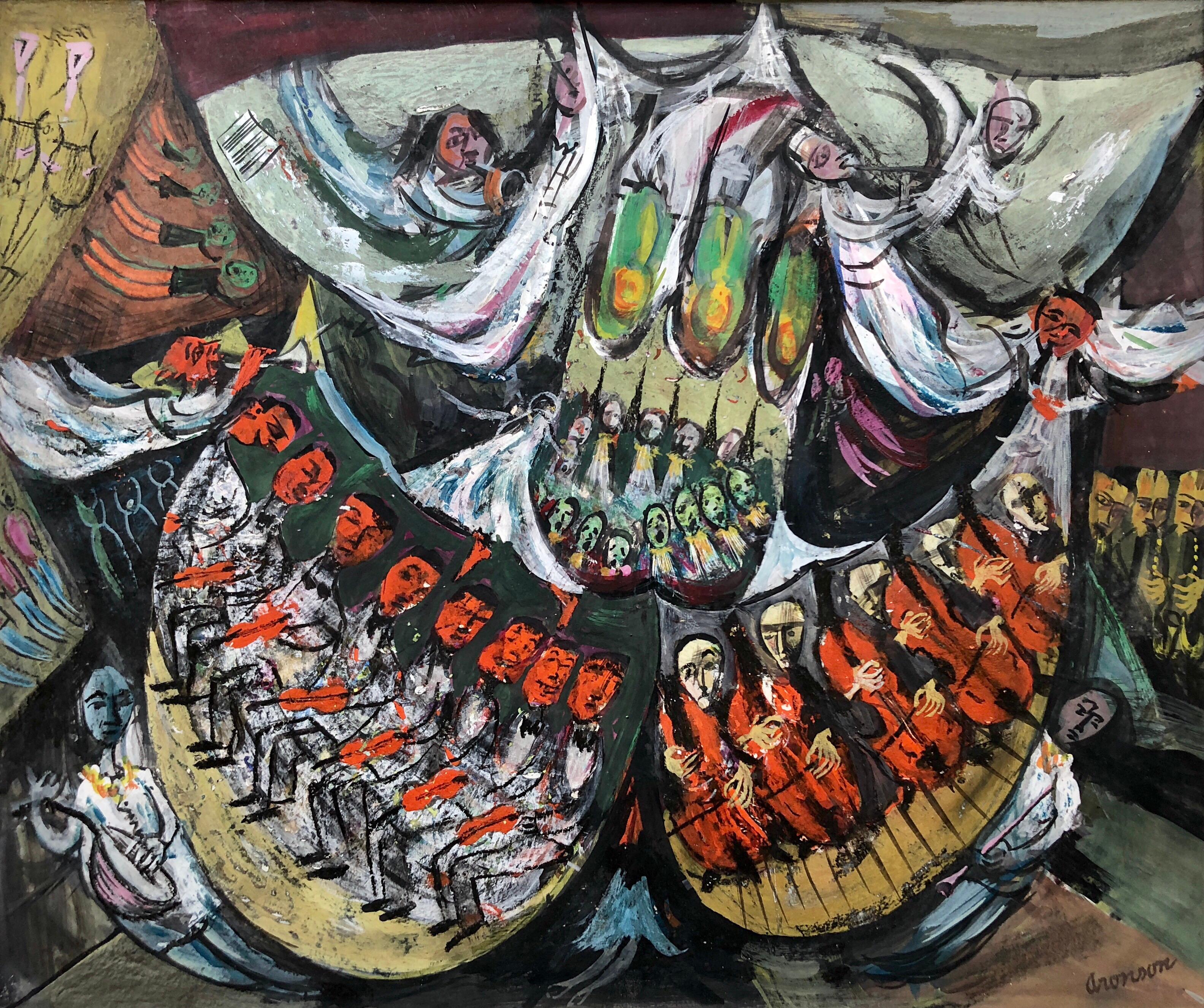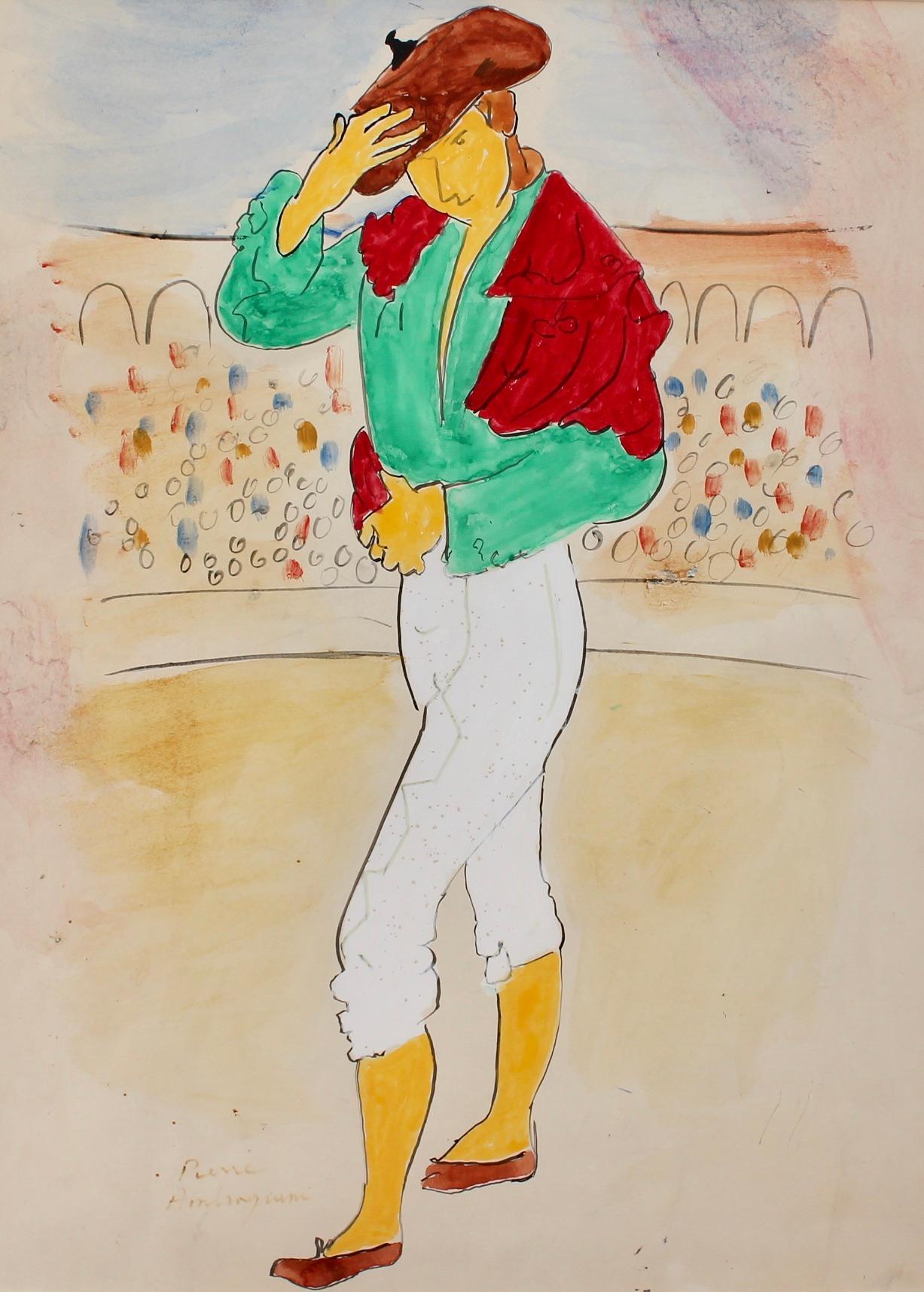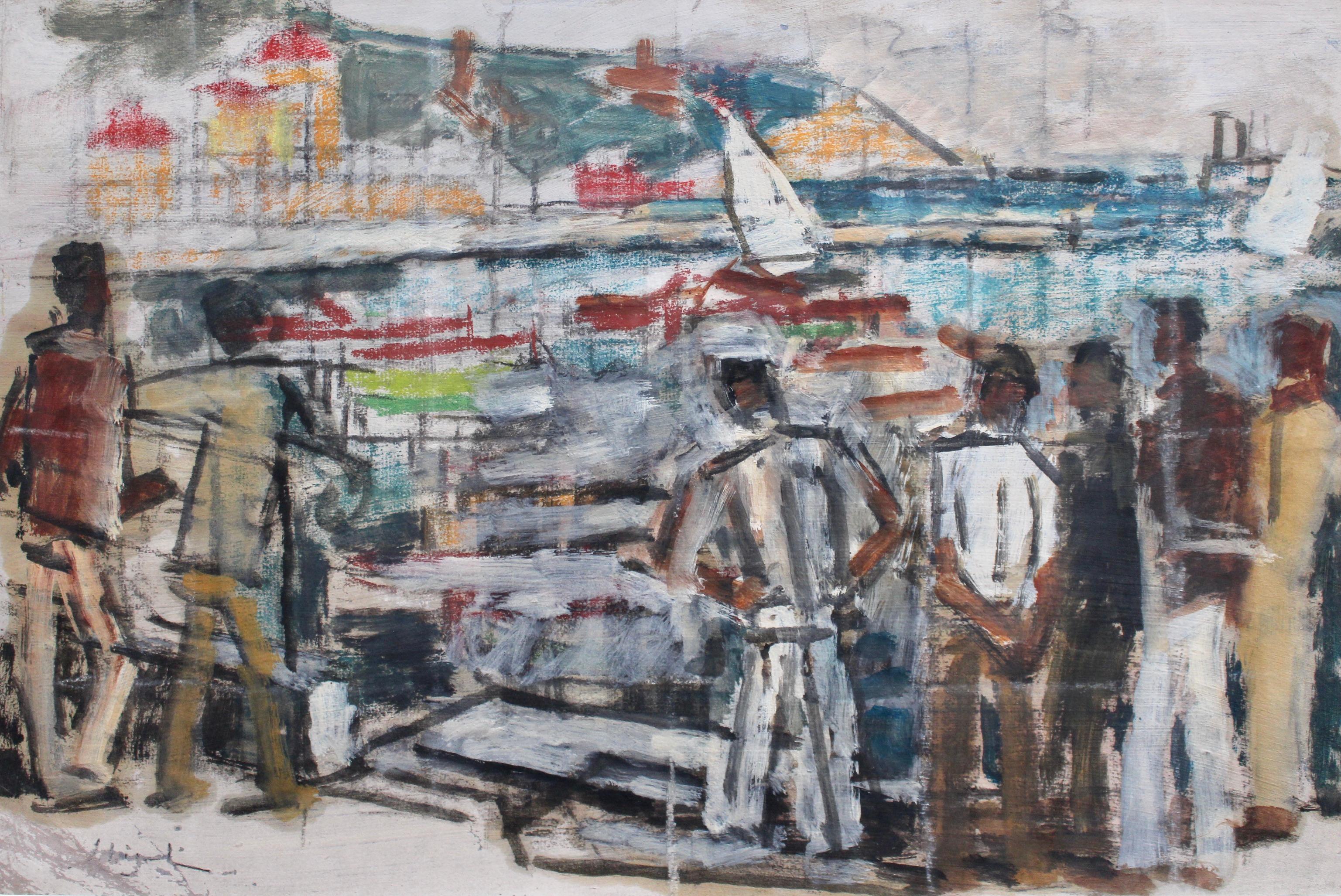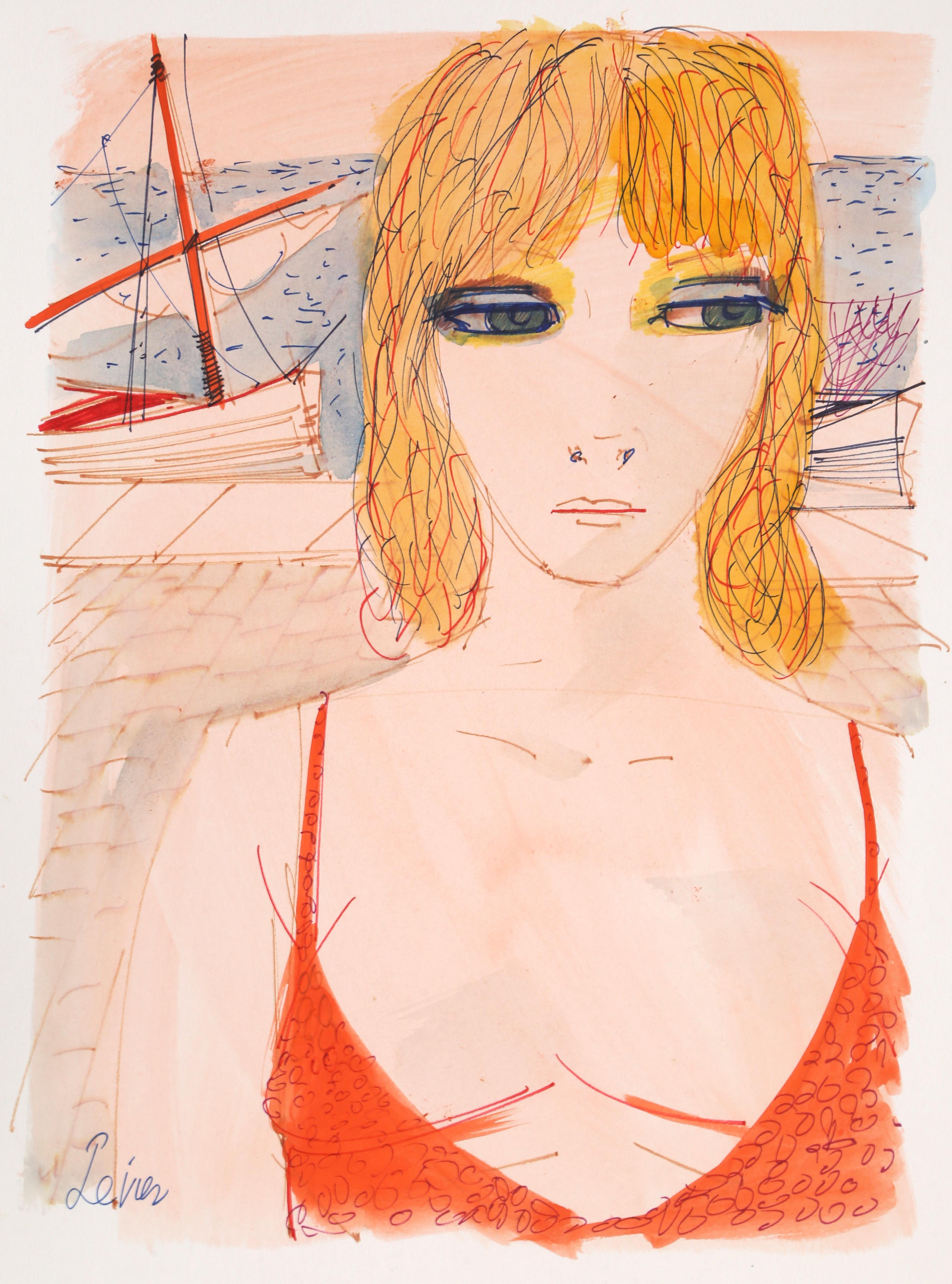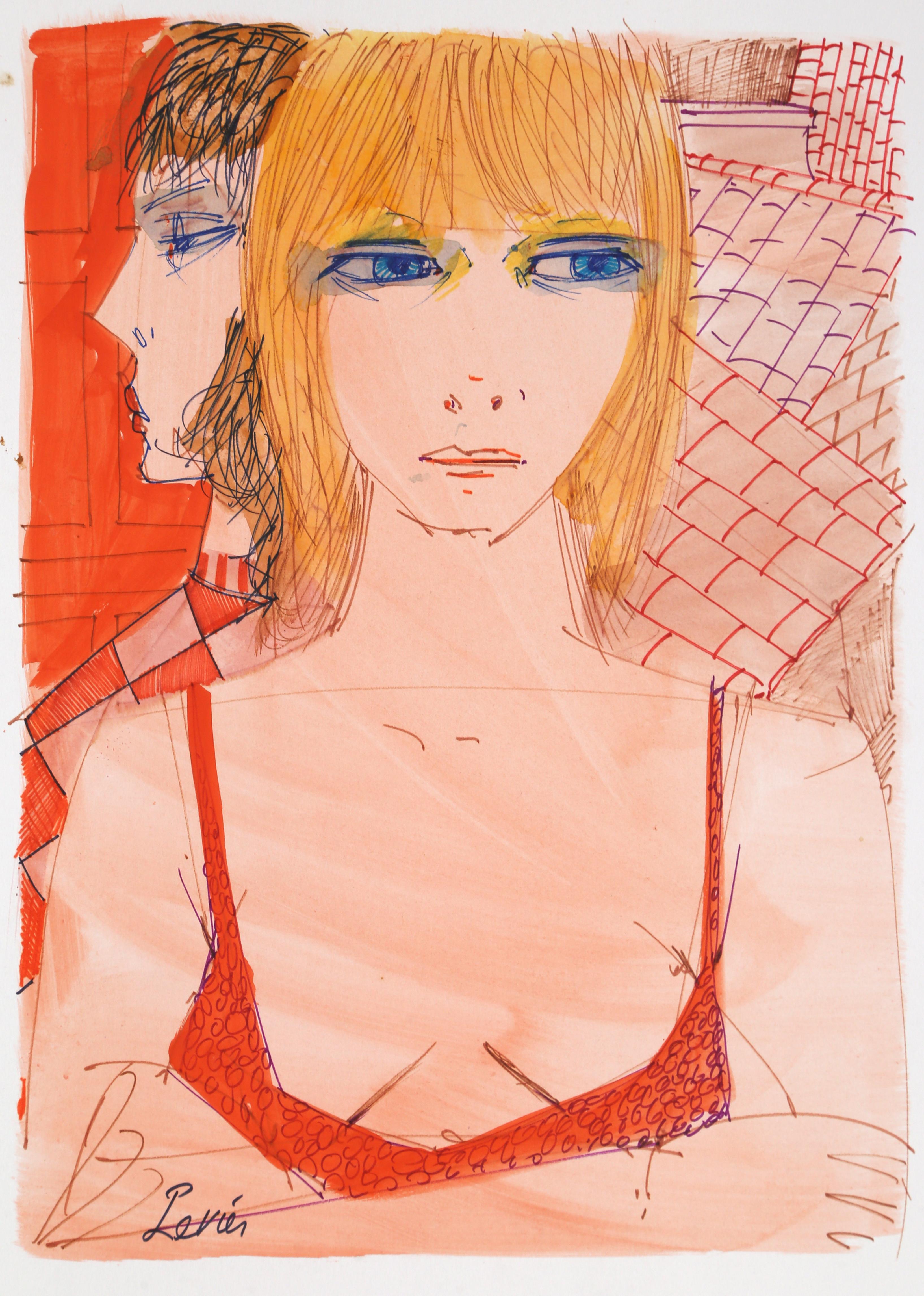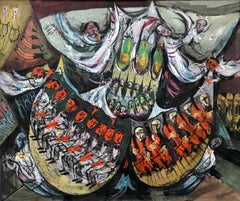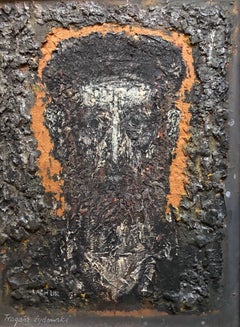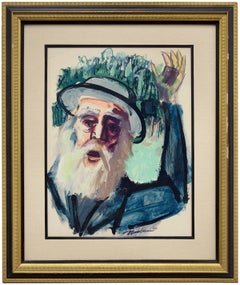
Chassidic Rabbi, Judaica Expressionist Painting
View Similar Items
Want more images or videos?
Request additional images or videos from the seller
1 of 7
Ervin B. NussbaumChassidic Rabbi, Judaica Expressionist Painting1966
1966
About the Item
- Creator:Ervin B. Nussbaum (1914-1996, American)
- Creation Year:1966
- Dimensions:Height: 24.25 in (61.6 cm)Width: 20.25 in (51.44 cm)
- Medium:
- Movement & Style:
- Period:
- Condition:
- Gallery Location:Surfside, FL
- Reference Number:1stDibs: LU3821839423
About the Seller
4.9
Platinum Seller
These expertly vetted sellers are 1stDibs' most experienced sellers and are rated highest by our customers.
Established in 1995
1stDibs seller since 2014
1,543 sales on 1stDibs
Typical response time: 1 hour
More From This SellerView All
- Chassidic Rabbi, Judaica Expressionist PaintingBy Ervin B. NussbaumLocated in Surfside, FLIn this painting, Nussbaum depicts a Rabbi as his subject; a recurrent figure in his body of work. The artist uses gestural marks and vibrant blue colors in this composition. Nussba...Category
20th Century Expressionist Portrait Paintings
MaterialsGouache
- Modernist Orchestra Musical Gouache Painting Boston ExpressionistBy David AronsonLocated in Surfside, FLVery vibrant, dynamic orchestra scene reminiscent of the work of Mopp (Max Oppenheim) David Aronson, (1923-2015) son of a rabbi, was born in Lithuania in 1923 and immigrated to America at the age of five. He settled in Boston, Massachusetts where he studied at the school of the Museum of Fine Arts under Karl Zerbe, a German painter well known in the early 1900s. Aronson later taught at the school of the Museum of Fine Arts for fourteen years and founded the School of Fine Art at Boston University where he is today a professor emeritus. An internationally renowned sculptor & painter, Aronson has won acclaim for his interpretation of themes from the Hebrew Talmud and Kabala. His best known works include bronze castings, encaustic paintings, and pastels. His work is included in many important public and private collections, and has been shown in several museum retrospectives around the country. He is considered to be one of the most important 20th century American artists. At twenty-two David Aronson had his first one-man show at New York's Niveau Gallery. The next year, six of his Christological paintings were included in the Fourteen Americans exhibition at Manhattan's Museum of Modern Art where Aronson’s work was included alongside abstract expressionists Arshile Gorky, Robert Motherwell and Isamu Noguchi. In the 1950s, Aronson turned more toward his Jewish heritage for the inspiration for his art. Folklore as well as Kabalistic and other transcendental writings influenced his work greatly. The Golem (a legendary figure, brought to life by the Maharal of Prague out of clay to protect the Jewish community during times of persecution) and the Dybbuk (an evil spirit that lodges itself in the soul of a living person until exorcised) frequently appear in his work. In the sixties, Aronson turned to sculpture. His work during this period is best exemplified by a magnificent 8’ x 4’ bronze door which now stands at the entrance to Frank Lloyd Wright's Johnson Foundation Conference Center for the Arts in Racine, Wisconsin. In the seventies and eighties, Aronson continued his work in pastel drawings, paintings, and sculptures, often exploring religion and the frailties of man's nature. During this time, in addition to a traveling retrospective exhibition and many one-man shows in New York, Los Angeles, Chicago, and Boston at the Pucker-Safrai Gallery on Newbury Street, Aronson won many awards and became a member of the National Academy of Design in New York. Two years ago he retired from teaching to work full-time in his studio in Sudbury, Massachusetts. included in the catalog Contemporary Religious Imagery in American Art Catalog for an exhibition held at the Ringling Museum of Art, March 1-31, 1974. Artists represented: David Aronson, Leonard Baskin, Max Beckmann, Hyman Bloom, Fernando Botero, Paul Cadmus, Marvin Cherney, Arthur G. Dove, Philip Evergood, Adolph Gottlieb, Jonah Kinigstein, Rico Lebrun, Jack Levine, Louise Nevelson, Barnett Newman, Abraham Rattner, Ben Shahn, Mark Tobey, Max Weber, William Zorach and others. Selected Awards 1990, Certificate of Merit, National Academy of Design 1976, Purchase Prize, National Academy of Design 1976, Joseph Isidore Gold Medal, National Academy of Design 1976, Purchase Prize in Drawing, Albrecht Art Museum 1975, Isaac N. Maynard Prize for Painting, National Academy of Design 1973, Samuel F. B. Morse Gold Medal, National Academy of Design 1967, Purchase Prize, National Academy of Fine Arts 1967, Adolph and Clara Obrig Prize, National Academy of Design 1963, Gold Medal, Art Directors Club of Philadelphia 1961, 62, 63, Purchase Prize, National Institute of Arts and Letters 1960, John Siimon Guggenheim Fellowship 1958, Grant in Art, National Institute of Arts and Letters 1954, First Prize, Tupperware Annual Art Fund Award 1954, Grand Prize, Third Annual Boston Arts Festival 1953, Second Prize, Second Annual Boston Arts Festival 1952, Grand Prize, First Annual Boston Arts Festival 1946, Traveling Fellowship, School of the Museum of Fine Arts 1946, Purchase Prize, Virginia Museum of Fine Arts 1944, First Popular Prize, Institute of Contemporary Art 1944, First Judge's Prize, Institute of Contemporary Art Selected Public Collections Art Institute of Chicago Virginia Museum of Fine Arts Bryn Mawr College Brandeis University Tupperware Museum, Orlando, Florida DeCordova Museum Museum of Modern Art Print Collection, New York Atlanta University Atlanta Art...Category
20th Century Expressionist Figurative Paintings
MaterialsGouache, Board
- Expressionist Polish Rabbi Portrait Oil Painting Zdzisława LachurBy Zdzislaw LachurLocated in Surfside, FLZdzisław Lachur (born on July 14, 1920 in Zagórz , died December 29, 2007 in Warsaw ) - Polish painter and graphic artist, founder of the first Polish label of drawing movies in Bielsko-Biała . In the years 1945-1950 he studied painting and graphics at the Academy of Fine Arts in Krakow . He was a pupil of prof. Eugene Eibisch . The artist's works were presented at collective and individual exhibitions at home and abroad, including in Jerusalem , London , New York , Stuttgart , Paris , Vancouver and Toronto . Lachur's paintings were in possession of, among others, George Harrison , former US lady Jacqueline Kennedy and singer Barbra Streisand . In recognition of his achievements in painting and graphics, in 1961 he received the Minister of Culture and Art Award for lifetime achievement, and in 1979 he was awarded the medal of the Israeli Institute Yad Vashem in recognition of his work devoted to the Jewish people. one of a number of great Polish jewish artists...Category
Mid-20th Century Expressionist Portrait Paintings
MaterialsOil, Board
- Rabbi Portrait, Acryclic on CanvasBy Moshe KatzLocated in Surfside, FLHighly textured portrait of an elderly rabbinic sage. Moshe Katz was born March 2, 1937 in Bucharest, Romania. With his parents, he fled the Nazis and with much difficulty successfully made it safely to Israel. His paintings have been displayed by Arts International in galleries across the globe since the fall of 1965. He received second prize in the Israeli Group Artist Show in Halfa in 1959. Exhibits featuring his paintings of the young artist in the United States have taken place in Philadelphia, Los Angles...Category
20th Century Expressionist Portrait Paintings
MaterialsAcrylic
- Bold Expressionist Rabbi, Judaica paintingBy Ted JaslowLocated in Surfside, FLTED JASLOW Brooklyn, New York, USA, b. 1934 Ted Jaslow (b.1934) was born in Brooklyn, New York, the grandson of a Russian woodcarver. He was initially interested in sculpture, and l...Category
20th Century Expressionist Portrait Paintings
MaterialsPaper, Oil
- Expressionist Judaica Rabbis Oil Painting Jewish American WPA Modernist Ben ZionBy Ben-Zion WeinmanLocated in Surfside, FLRabbinical Discussion Hand signed lower left. Provenance: bears label verso for Summit Gallery Dimensions: H 14.25" x W 8" Born in 1897, Ben-Zion Weinman celebrated his European Jewish heritage in his visual works as a sculptor, painter, and printmaker. Influenced by Spinoza, Knut Hamsun, and Wladyslaw Reymont, as well as Hebrew literature, Ben-Zion wrote poetry and essays that, like his visual work, attempt to reveal the deep “connection between man and the divine, and between man and earth.” An emigrant from the Ukraine, he came to the US in 1920. He wrote fairy tales and poems in Hebrew under the name Benzion Weinman, but when he began painting he dropped his last name and hyphenated his first, saying an artist needed only one name. Ben-Zion was a founding member of “The Ten: An Independent Group” The Ten” a 1930’s avant-garde group, Painted on anything handy. Ben-Zion often used cabinet doors (panels) in his work. Other members of group included Ilya Bolotowsky, Lee Gatch, Adolph Gottlieb, Louis Harris, Yankel Kufeld, Marcus Rothkowitz (later known as Mark Rothko), Louis Schanker, and Joseph Solman. The Art of “The Ten” was generally described as expressionist, as this style offered the best link between modernism and social art. Their exhibition at the Mercury Gallery in New York held at the same time as the Whitney Annual Exhibition of Contemporary American Painting, included a manifesto concentrating on aesthetic questions and criticisms of the conservative definition of modern art imposed by the Whitney. Ben-Zion’s work was quickly noticed. The New York Sun said he painted “furiously” and called him “the farthest along of the lot.” And the triptych, “The Glory of War,” was described by Art News as “resounding.” By 1939, The Ten disbanded because most of the members found individual galleries to represent their work. Ben-Zion had his first one-man show at the Artist’s Gallery in Greenwich Village and J.B. Neumann, the highly esteemed European art dealer who introduced Paul Klee, (among others) to America, purchased several of Ben-Zion’s drawings. Curt Valentin, another well-known dealer, exhibited groups of his drawings and undertook the printing of four portfolios of etchings, each composed of Ben-Zion’s biblical themes. He worked as a WPA artist. Ben-Zion’s work is represented in many museums throughout the country including the Metropolitan, the Whitney, and the Museum of Modern Art in New York, the Art Institute of Chicago, the Philadelphia Museum of Art and the Phillips Collection, Washington. The Jewish Museum in New York opened in 1948 with a Ben-Zion exhibition. Ben-Zion consistently threaded certain subject matter—nature, still life, the human figure, the Rabbi, the Hebrew Bible, and the Jewish people—into his work throughout his life. "In all his work a profound human feeling remains. Sea and sky, even sheaves of wheat acquire a monolithic beauty and simplicity which delineates the transient as a reflection of the eternal. This sensitive inter- mingling of the physical and metaphysical is one of the most enduring features of Ben-Zion's works." (Excerpt from Stephen Kayser, “Biblical Paintings,” The Jewish Museum Catalogue, 1952). Mystical Imprints: Marc Chagall, Ben-Zion, and Ben Shahn presents the print work of three prominent 20th century Jewish artists born in the Russian Empire. Among these seventy pieces are etchings and lithographs from Chagall’s Bible series...Category
Mid-20th Century Expressionist Figurative Paintings
MaterialsOil, Wood Panel
You May Also Like
- MId Century Animal Portrait: "Rooster" Pierre Bosco (1909-1993)By Pierre BoscoLocated in SANTA FE, NM"Rooster" Pierre Bosco, (1909-1993) Gouache on paper 10 x 9 (18 x 14 frame) inches Pierre Bosco showed an interest in art at an early age. His commitment and dedication to painting...Category
1960s Expressionist Animal Paintings
MaterialsPaper, Gouache
$1,900 Sale Price33% Off - Janine, The MuseBy Armand AvrilLocated in Cotignac, FRA vibrant colourful French portrait of Janine, muse of the artist Armand Avril. Signed and dated mid right. Presented in new contemporary framing under glass. Armand Avril (1926) i...Category
Late 20th Century Expressionist Figurative Paintings
MaterialsPaper, Oil, Acrylic, Gouache
- Portrait of a Man by Swedish Artist Martin Eder, 1954, Gouache on MasoniteBy Martin EderLocated in Stockholm, SEMartin Eder was a Swedish drawing teacher, artist and ceramicist. Martin was born on the island of Gotland and spent a lot of time there, he also lived in Sala. Martin was a curious ...Category
1950s Expressionist Mixed Media
MaterialsMasonite, Gouache
- La MonteraBy Pierre AmbrogianiLocated in London, GB'La Montera', gouache, watercolour and ink on art paper, by Pierre Ambrogiani (circa 1960s). The artist created many artworks with bullfighting as theme. In this case, a single torer...Category
1960s Expressionist Portrait Drawings and Watercolors
MaterialsPaper, Watercolor, Gouache
$1,219 Sale Price40% Off - Sailors in the Port of NiceBy Alfred SalvignolLocated in London, GB'Sailors in the Port of Nice', mixed media - gouache, pastel and oil on paper, by Alfred Salvignol (circa 1950s). The Port of Nice is one of the key hubs of Nice and, in fact, of the...Category
1950s Expressionist Mixed Media
MaterialsPaper, Pastel, Oil, Gouache
$800 Sale Price30% Off - Portrait of Young Girl Gouache Painting by Max MoreauBy Max MoreauLocated in Atlanta, GA1950s portrait, gouache on paper painting by Belgian artist Max Moreau (1902 - 1992). A finely detailed portrait of a lovely young girl looking like a good child from the period right after WWII. Moreau captures the sweet expression, soft features, and calm, well-mannered demeanor of that child. Hand-signed and dated on the bottom right corner. The artist demonstrates incredible skill in detailing this portrait with gouache and watercolor. This skill has made his portraits so desirable for international collectors. The painting still has its original elegant mahogany carved frame with glass protection. Measurements: With frame: 25.19 in wide (64 cm) x 30.32 in high (77 cm) x 2.38 in deep (6 cm). Opening view: 19.69 in wide (50 cm) x 24.50 in high (62 cm). Note: Max Leon Moreau (1902 - 1992) Moreau is a highly acclaimed artist born in Belgium. He is best known for his loosely brushed street scenes of Paris, Granada, and North Africa and his revealing portraits of met characters during his foreign travels. Taught to paint by his father, the family moved to Paris, where he made copies of paintings at the Louvre Museum. Later Moreau and his family lived in Tunisia and Morocco before settling in Granada, Spain. Following his death in 1992, his home was converted into a museum dedicated to his life and work. His paintings are internationally collected and appear at auction in major international houses. Max spent his last 30 years living in his Moorish-style house in Granada, which upon his death, was bequeathed to the City of Granada along with the contents of his studio and artwork. The City of Granada has turned his home into a museum showcasing his paintings, studio, and private life. The main building of the Casa Museo Max Moreau houses an exhibition space that takes us on a journey through his most common themes: portraits, still-life, and landscapes, represented through oil paintings, watercolors, and drawings on paper. There is also a series of models for theatre creations that illustrate his interest and relationship to the scenic arts (he was involved in many productions as an actor, playwright, musician, and set designer). The building is an original from the region of Albayzín and is popularly known as Carmen. Does the name come from the Arabic word Karm which means vine, orchard, or garden.?The second building houses his studio, remained untouched: the easel next to the window, a piano with scores, and a collection of oriental objects...Category
1950s Expressionist Portrait Paintings
MaterialsPaper, Gouache
Recently Viewed
View AllMore Ways To Browse
Judaica Rabbi Portrait
19th Century Portrait Painting Lady
Oil Painting Beautiful Lady
White Court Art
19th Century Portraits Women
Women Portraits 19th Century
Women Portraits 19th Century
Lady In White Dress
Blue Lady Painting
19th Century Portraits Of Women
18th Century French Portrait Painting
19th Century Victorian Oil Portrait
Gerard Oil Painting
18th Century English Oil Paintings
19th Century Children Portraits
Lady In A White Dress
Oil Painting Of Beautiful Lady
John Hair
